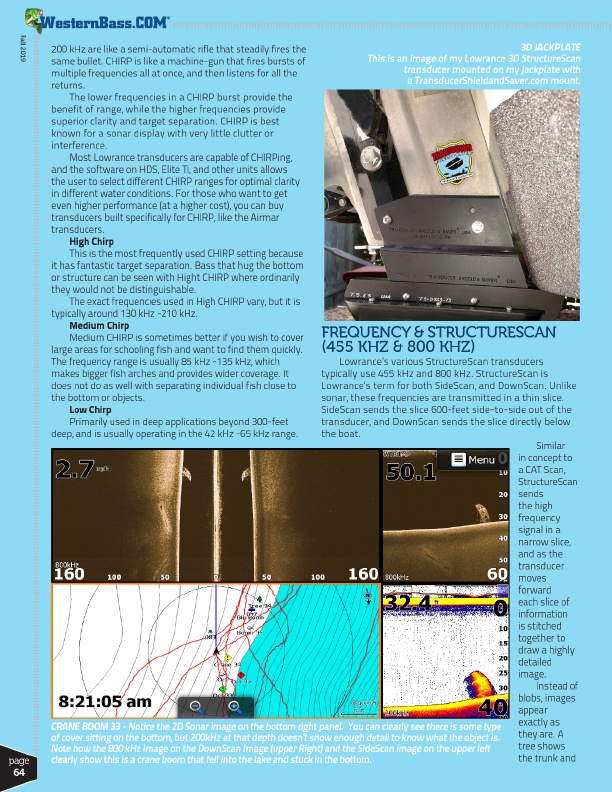
®
Fall 2019
page 64
200 kHz are like a semi-automatic rifle that steadily fires the same bullet. CHIRP is like a machine-gun that fires bursts of multiple frequencies all at once, and then listens for all the returns.
3D JACKPLATE This is an image of my Lowrance 3D StructureScan
transducer mounted on my jackplate with
a TransducerShieldandSaver.com mount.
The lower frequencies in a CHIRP burst provide the
benefit of range, while the higher frequencies provide
superior clarity and target separation. CHIRP is best
known for a sonar display with very little clutter or
interference.
Most Lowrance transducers are capable of CHIRPing,
and the software on HDS, Elite Ti, and other units allows
the user to select different CHIRP ranges for optimal clarity
in different water conditions. For those who want to get
even higher performance (at a higher cost), you can buy
transducers built specifically for CHIRP, like the Airmar
transducers.
High Chirp
This is the most frequently used CHIRP setting because
it has fantastic target separation. Bass that hug the bottom
or structure can be seen with Hight CHIRP where ordinarily
they would not be distinguishable.
The exact frequencies used in High CHIRP vary, but it is
typically around 130 kHz -210 kHz.
Medium Chirp
Medium CHIRP is sometimes better if you wish to cover large areas for schooling fish and want to find them quickly.
FREQUENCY & STRUCTURESCAN (455 KHZ & 800 KHZ)
The frequency range is usually 85 kHz -135 kHz, which
Lowrance’s various StructureScan transducers
makes bigger fish arches and provides wider coverage. It
typically use 455 kHz and 800 kHz. StructureScan is
does not do as well with separating individual fish close to
Lowrance’s term for both SideScan, and DownScan. Unlike
the bottom or objects.
sonar, these frequencies are transmitted in a thin slice.
Low Chirp
SideScan sends the slice 600-feet side-to-side out of the
Primarily used in deep applications beyond 300-feet
transducer, and DownScan sends the slice directly below
deep, and is usually operating in the 42 kHz -65 kHz range. the boat.
Similar
in concept to
a CAT Scan,
StructureScan
sends
the high
frequency
signal in a
narrow slice,
and as the
transducer
moves
forward
each slice of
information
is stitched
together to
draw a highly
detailed
image.
Instead of
blobs, images
appear
CRANE BOOM 33 - Notice the 2D Sonar image on the bottom right panel. You can clearly see there is some type of cover sitting on the bottom, but 200kHz at that depth doesn’t show enough detail to know what the object is. Note how the 800 kHz image on the DownScan Image (upper Right) and the SideScan image on the upper left clearly show this is a crane boom that fell into the lake and stuck in the bottom.
exactly as they are. A tree shows the trunk and